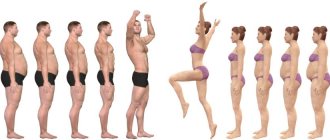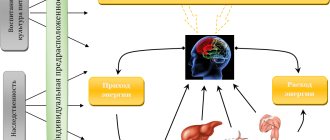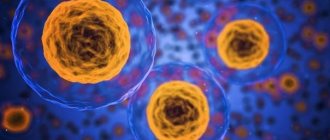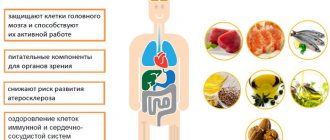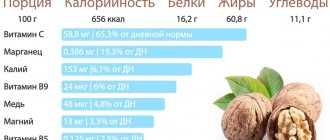Wanting to lose weight, a person wants to get rid of excess fat. However, if a person does this incorrectly, then he loses muscle mass along with fat, or gets rid of only it. To lose weight correctly, you need to understand how fat is burned in the body and through what processes this happens.
Process one. Release of fat from fat cells
Fat is located in fat cells, the number of which does not change in a person regardless of the amount of fat. That is, when losing weight, we get rid not of fat cells, but of the fat contained in them. The more it is in the cells, the greater their size and weight. Fat cells tend to stretch greatly.
Recently, scientists have proven that the number of fat cells can change throughout life, but the change is insignificant.
The first thing that happens when fat leaves the body is its release. To do this, you need to create an energy deficit in the body. Then special hormones and enzymes are released into the blood, transported through the bloodstream to fat cells and releasing fat from them.
To create an energy deficit, without which fat in the human body does not burn, you need to spend more energy than you consume. Diet restrictions and physical activity are used for this purpose.
What foods burn fat in the body?
Vitamin D
Let's start looking at foods that burn fat in the body and vitamin D and food that contains it.
How does it help burn fat? The “sunshine” vitamin helps the body’s cells respond to insulin as needed. This hormone is produced by the pancreas. This is evidenced by numerous studies. One of its most important functions is to deliver glucose to cells, which burn it and thereby obtain energy. That factor, which indicates how much insulin helps glucose get into cells, is called “insulin sensitivity.” You are lucky if your cells are very sensitive to insulin. But if sensitivity is low, then the likelihood that the calories you consume will accumulate in fat cells increases.
When the body experiences a lack of vitamin D, levels of parathyroid hormone (PTH), produced by the parathyroid gland, increase. “Elevated levels of PTH promote reactions that ultimately cause fat cells to convert sugar into fat and cause fat to be stored rather than burned,” explains the director of the University of Tennessee Institute of Nutrition, in the city of Knoxville, Michael B. Zemel.
Lack of vitamin D also negatively affects leptin. This hormone tells the brain that it is time to stop eating. If your body does not feel full, you will eat non-stop.
Calcium
How can calcium help you lose weight? The mineral calcium is a faithful partner of vitamin D in burning extra pounds. Here's how this tandem works: calcium is present in fat cells, and the more of it, the more actively the cell uses it to burn calories. In addition, calcium binds fats passing through your intestinal tract, thereby promoting weight loss. It simply prevents fat from entering the bloodstream.
Protein
How does protein get rid of fat? If you want to have a balanced body composition, then eat protein; it helps ensure that the proportion of fatty tissue and muscle tissue is ideal. An effective trio of calcium, protein and vitamin D to help you shed pounds while maintaining muscle. It's interesting to look at the results of a study from the University of Illinois: those women who took protein twice a day lost 3.9% more excess weight than those who neglected it. Plus, these women not only lost weight, but also became stronger.
If you decide to buy powders for cocktails at a sports store, but are worried whether protein is a chemical or not, read the article to understand the issue. At the same time, you will learn what types exist, how to choose and how to drink.
Omega-3 fatty acids
How can fatty acids get rid of fat?
Omega-3 fatty acids are truly magical. They influence enzymes that promote fat burning in cells. In addition, they also affect our mood, which means we become less susceptible to so-called emotional overeating. Together with vitamin D, they help leptin tell the brain that it’s time to get up from the table. Fatty fish are rich in these miraculous acids, especially salmon. And nuts and seeds contain a special type of fat that is converted into omega-3 fatty acids in the body.
MUFA - monosaturated fatty acids
How do they help burn fat? As an illustrative example, one study was conducted in Denmark and involved 26 people. They ate seeds, olive oil, avocados, chocolate, peanut butter and nuts, i.e. They got 20% of their calories from monosaturated fatty acids. What did the results show? After six months of dieting, calorie burning per day increased by 0.1%, and fat burning by 0.04%. Other scientific studies show that this type of acid does not increase fat deposits. Some of the foods high in these acids, especially olive oil, peanuts and nuts, help stabilize blood sugar levels and help reduce appetite.
Conjugated linoleic acid
How does she burn fat? These acids are the most effective fat burners. They can be found in dairy products, along with vitamin D and calcium. These types of fatty acids are formed in the stomachs of ruminants when bacteria ferment food. These acids, produced during fermentation, can be found in the milk and meat of sheep and cows.
When we include these products in our diet, conjugated linoleic acids help ensure that glucose from the blood enters the cells and is not retained there as fat. These acids also help burn fat in the muscles, where most calories are burned.
However, there is one catch: all of these studies used huge amounts of this acid, comparable to if you ate 18 kilograms of beef alone at a time. And yet, despite the fact that it is not possible to consume such an amount of meat, you should not neglect eating foods rich in this substance. It will promote proper metabolism. Together with vitamin D, calcium and protein, it will help create ideal conditions in the body for getting rid of excess fat.
Polyphenols
How do polyphenols affect body fat? First, let's define polyphenols: these are antioxidants found in green tea, which is why this drink is so beneficial to health and helps you lose extra pounds. Scientific studies show that polyphenols speed up metabolism by 17%. Scientists conducted an experiment on rats. They were given very fatty food and green tea. The results showed that the rats did not gain weight despite the high-calorie diet. You yourself can feel the magic of green tea - after just one cup, your body feels warm - this is how the body spends calories, burning them as heat. Therefore, when you are cold or hungry, drink a glass of green tea, it will warm you up and dull the feeling of hunger.
Now you also know foods that burn fat in the body. More precisely, we tried to talk not about the fat-burning products themselves, but specifically about the components that contribute to the breakdown of fat deposits.
But we would like to remind you that for proper and healthy weight loss you need to follow the rules of energy balance (expend more calories than we consume). And place more emphasis on healthy foods and exercise to increase calorie expenditure.
https://www.womenshealthmag.com/weight-loss/weight-loss-supplements
Process two. Transporting fat to muscles and burning it
Once released from the fat cells, the fat is transformed into muscle along with the blood. Reaching the muscle, it must burn in the mitochondria, which are the so-called “power plants” of humans. And to burn fat, it needs enzymes and oxygen. If there are not enough of them in the body, fat will not be able to be transformed into energy and will be deposited in the body again.
That is, to break down fats in the human body, they need to be released from fat cells through enzymes and hormones. They are then transported to the muscle and burned through a reaction with oxygen and enzymes.
It is this process of fat breakdown that is natural weight loss. Therefore, in order for it to be correct, the body needs physical activity, accompanied by the consumption of a large volume of oxygen, and at the same time the presence of all the enzymes necessary for burning fat. To do this, you need proper nutrition with a sufficient amount of protein food, since it contains enzymes to a greater extent.
Triacylglycerides (TG)[edit | edit code]
B. Fat Absorption Dietary
triacylglycerols are broken down into free fatty acids (FFA) and 2-monoacylglyceride (MG) in the gastrointestinal tract (B). Because short-chain free fatty acids are water-soluble, they can be absorbed and transported to the liver via the portal vein. Long chain fatty acids and 2-monoacylglycerol are insoluble in water. They are converted back into TG (B) in the cells of the mucous membrane. (FFAs necessary for TG synthesis are transported by FFA-binding proteins from the cell membrane to the sites of synthesis, i.e., to the smooth endoplasmic reticulum.) Since TGs are insoluble in water, they are subsequently incorporated into chylomicrons, which, in turn, are exocytosed into the extracellular fluid, then pass into the intestinal lymph (passing again through the liver), from where they ultimately enter the systemic circulation (C, D). (Blood plasma becomes cloudy approximately 20-30 minutes after eating a fatty meal due to the presence of chylomicrons in it.) The liver also synthesizes TG, taking the necessary FFAs from the plasma or synthesizing them from glucose. TG with VLDL (see earlier) are then secreted into the plasma (D).
D. Metabolic pathways of triacylglycerides and free fatty acids
Because the export capacity of this mechanism is limited, excess FFA or glucose (G) can lead to accumulation of TG in the liver (fatty liver).
Free fatty acids (FFA)
are high-energy substrates used for energy metabolism. Fatty acids circulating in the blood exist mainly in the form of TG (as part of lipoproteins), and plasma FFAs form complexes with albumin. Fatty acids are removed from chylomicron TGs and VLDL by lipoprotein lipase (LLP) on the luminal side of the endothelium of capillaries in many organs (mainly in adipose tissue and muscle) (D). ApoCH on the surface of TG and VLDL activate LLP. Insulin secreted after a meal induces LLP (G), which promotes rapid degradation of reabsorbed dietary TG. LLPs are also activated by heparin (from endothelial tissue, from mast cells, etc.), which allows the removal of chylomicrons from turbid plasma; and therefore it is also called plasma clearing factor. FFAs in complexes with albumin in plasma are mainly transported to targets (D).
- Into cardiac muscle, skeletal muscle, kidneys and other organs, where they are oxidized to CO2 and H2O in mitochondria (β-oxidation) and used as a source of energy.
- Into fat cells (G), which either store FFA or use them for the synthesis of TG. When energy needs increase or the supply of FFAs in fat cells decreases, they are cleaved from triacylglycerides (lipolysis) and transported to those areas where they are needed (D). Lipolysis is stimulated by adrenaline, glucagon and cortisol and inhibited by insulin.
- To the liver, where FFAs are oxidized or used for TG synthesis.
Features of the process of burning fat in the body
The body has two main energy sources - glycogen and fat. Glycogen is a more powerful source and is easier to convert into energy than fat. Therefore, the body first tries to burn it, and only then does it turn to fat.
Hence, it is important that the workout lasts at least an hour, because otherwise the body, burning glycogen, may not reach fat.
Physical activity with high oxygen consumption is aerobic exercise, that is, running, cycling, swimming, and so on . It is these types of exercises that promote active fat burning, so if you want to lose weight, focus on them rather than on strength training. Strength exercises, of course, will help train muscles, but under a layer of fat they simply will not be visible.
Ideally, it is recommended to combine aerobic and strength training , since running or cycling alone will not help you get the desired result - the body tends to adapt to monotonous loads. It is thanks to alternating loads that you can achieve the desired result. Moreover, the more muscles in the body, the more actively fat is burned, so proper weight loss should include strength training.
In simple terms, fat breaks down into carbon dioxide and water, and at the same time energy is released. Carbon dioxide is excreted through the lungs, water is excreted through urine and sweat, and the body uses energy for work. This is the answer to the question of where fat goes when a person loses weight.
And one more point that misleads many. Fat is a source of energy and is distributed evenly throughout the body. It is impossible to burn it in only one area - on the stomach or legs. Therefore, when losing weight, the whole body loses weight, and in the future you can correct problem areas with strength exercises.
You also need to take into account that each person has genetic characteristics, due to which fat in specific areas can be lost better than in others.
How fat is stored in the body
You also need to understand how fat is formed in the human body. The presence of fat deposits on the human body is a normal indicator of the body’s protective reaction, or more precisely, a natural survival mechanism. In ancient times, it was thanks to fat that a person could survive in severe cold. Today there is no such need, but fat still accumulates. How does this happen?
First of all, carbohydrates, especially simple sugars, are transformed into fat cells. Of course, like other substances, the body needs them. They are deposited in the muscles, and this becomes the main source of energy for strength work, and for any load in principle. But the maximum amount that can accumulate in the muscles is 60-90 grams of carbohydrates, and another 70-80 grams can be deposited in the liver. There are no other places for their storage in the body. Therefore, when carbohydrates are consumed in excess of the norm, they are transformed into fat deposits and “settle” on the stomach, hips, legs and other parts of the body.
Another point is that fat can be drawn directly from fat . The body also needs fats, especially women to maintain the functioning of the hormonal, reproductive and cardiovascular systems. However, a gram of pure fat contains about 9 kcal, respectively, 100 grams of it - 900 kcal, and this is not so far from the daily calorie intake of a person who wants to lose weight. Calories from fat are stored by the body easier and faster than those coming from carbohydrates, since fat is difficult to break down and is the last source of energy to be used.
Where and how is fat accumulated in the body? Many people think that it is deposited only under the skin, since these deposits can be seen with the naked eye. Most of it actually accumulates here, but the skin-fatty tissue is located not only directly under the skin, but also inside, enveloping the internal organs, which is necessary to protect them. This type of fat is called visceral or abdominal , since the most important organs are located in the abdominal or sternum areas. But if the amount of subcutaneous fat exceeds the norm, this is fraught with obesity, disturbances in the functioning of the cardiovascular system and the resulting numerous negative consequences.
Breakdown of fats in the body. Fat metabolism.
Today we will understand how fat is formed and broken down in our body. This process as a whole is called lipid metabolism (or fat metabolism).
In fact, such a colossal number of chemical reactions and transformations occur in the body that a detailed explanation of the entire process of fat metabolism would require a series of many hours of lectures and excellent knowledge of biochemistry.
Of course, I’m not going to burden you with sheets of formulas, therefore, we will consider fat metabolism in a very simplified version and only from the side that is important for you and me - from the point of view of losing weight.
First, let's discuss in detail the process of fat formation in our body.
It is interesting that our body can obtain fats not only directly from fats found in food, but also from carbohydrates and even proteins. And now we will look at all 3 ways to obtain fats in more detail.
So, the fats that make up the food enter the gastrointestinal tract, where they are broken down into fatty acids and glycerol. Then it is all absorbed and enters the blood and lymph, through which it is delivered to the cells of our body. If some cells require fat (for example, muscle cells need energy), then fatty acids are consumed by these cells. If the body does not require energy, then entering special fat cells (lipocides), fatty acids can be stored “in reserve” in the form of substances called “triglycerides”. Our fat reserves are stored in fat cells, and it is fat cells with large amounts of accumulated triglycerides that create discomfort in the form of excess weight.
The formation of fat deposits from carbohydrates is as follows: first, carbohydrates are broken down into glucose and fructose, and then triglycerides are formed from them in fat cells with the participation of insulin.
The process of forming fat deposits from proteins is much more complicated. To obtain fat from protein, it is first necessary to break down the protein into amino acids, then in the liver the amino acids are converted into glucose, and then triglycerides are formed from glucose with the participation of insulin in fat cells.
From this we can immediately draw a rather important conclusion:
It’s the hardest thing for our body to “make” fat from proteins!
Many different diets are based on this fact, for example, the Dukan diet. However, such diets have negative health consequences and I recommend avoiding them. There are much better and simpler ways to lose weight than exhausting yourself with “miracle diets.”
It is worth noting that fat has many functions in our body. It not only serves as the main energy reserve of our body, but is also a building material for cell membranes and a number of hormones. Therefore, we cannot completely get rid of adipose tissue. Without fat tissue, our body will not be able to function normally. When we talk about losing weight, we are trying to get rid of excess fat, but not all fat. Some percentage still remains.
It is worth noting that a woman’s body is more prone to accumulating fat and is less inclined to then break down this fat. This is related to reproductive function. To perform this function, a huge supply of energy is required. A huge amount of energy is spent on the formation of the fetus, on its vital activity and development. Also, during the formation of the fetus, the active construction of new cells takes place, which require membranes that are built from fats. In the natural world there is no guarantee that food will always be available and therefore energy reserves are necessary.
The minimum amount of body fat below which there is a risk of death:
- in men: about 5%
- in women: about 10%
Now we need to understand how the fat reserves of our body are obtained, broken down and then consumed.
So, fat is deposited in the form of triglycerides in the fat cell. And it's time to use it. This occurs when there is not enough energy coming from the digestive system or fat is required as a building material for cell membranes. At this moment, a signal is given to the fat cells. This signal is given in a humoral way (that is, with the help of hormones). This is not just one hormone, but a whole set of different hormones that have a lipolytic effect (the ability to break down fats).
For example, at a time of stress, the body releases a special hormone - adrenaline, which breaks down fat (the body prepares to have the energy for active actions - for example, to run away from danger).
If a person has not eaten for a long time, the digestive system is empty, and the level of glucose in the blood drops. A special hormone is released - “glucagon”, which removes glucose from the liver. Also, this hormone has a lipolytic effect.
If a person does not eat for a very long time, or experiences physical or emotional overload, a hormone is released - cortisol. Fat also breaks down somatotropin. It stimulates protein synthesis and, among other things, for this purpose, it gives the command to break down fats. Since protein synthesis requires a huge amount of energy, which is obtained in the form of ATP from fats.
Thyroid hormones and many other hormones also break down fat.
Having received a command from hormones, the fat cell breaks down fat into:
- glycerol
- fatty acid
Which enter the bloodstream and lymph flow.
In this case, fatty acids, which cannot be transported on their own, combine with special proteins and form “fat-proteins” or, scientifically, “lipoproteins”.
Next, lipoproteins, “driving” past a cell that requires energy, interact with special enzymes on the cell membrane, which break down lipoproteins and take fatty acid for further use (producing energy or building membranes).
It is worth noting that often incorrect conclusions are drawn from the process of fat metabolism. For example, a person heard that the signal for the breakdown of fat is given by adrenaline, which is released at times of stress. And there are special pills that stimulate the production of adrenaline, and you need to eat them to break down fat. But the breakdown of fat is not yet its oxidation (that is, simply breaking it down and entering it into the blood is NOT fat consumption). Oxidation (that is, the direct consumption of fat for energy or the construction of membranes) will begin to occur only when this fat is needed by the cells it “floats” past. If no cells require energy, then everything will simply end with fats being released into the blood and floating there. These fats will be deposited on the walls of blood vessels, which is very bad and can lead to atherosclerosis, blockage of blood vessels, strokes, etc. Therefore, people who are often nervous are more susceptible to this type of disease.
Thus, it is necessary not only to break down fats, but also to create conditions for them to be consumed by cells (to create a lack of energy in the cells).
If you liked the article, subscribe to the blog and be the first to know when new useful articles about effective and safe weight loss are released.
Author of the article: Yulia Lakman
© Hudeem-s-profi.ru. When copying any part of the article, a link to the original source is required.
Features of proper fat burning
Subcutaneous fat tissue disappears quite quickly. But visceral fat is burned more difficult and slower. But it is very important to fight its excess to maintain the normal functioning of the body and all its systems.
Initially, proper nutrition is important, since fat is burned when there is a lack of energy. You need to start by counting calories. You can eat fully, consuming all the necessary substances, however, reduce calories to 1500-1800 kcal per day for women, and 2000-2300 kcal for men. First of all, of course, it is important to reduce the amount of fatty foods in your diet. Sources of fats should be healthy: sea fish, vegetable oils, nuts . It is also important to limit simple carbohydrates such as sugar, sweets, baked goods, and sugary waters. Sources of carbohydrates should be healthy - cereals, fruits and vegetables, whole grain bread.
Workouts, namely aerobic exercise, are very important for proper fat burning. They provide the best supply of oxygen to the body, and it is he who is the main assistant in burning fat. And don’t forget that cardio training should last at least 30-40 minutes so that the body uses up glycogen and has time to get to fat.
In fact, any exercise will be effective for burning fat, and you can choose the ones that you like best. How much you burn will be determined by the intensity of the workout, physical fitness, age - the older the person, the longer the storage systems work, muscle mass. The frequency of training is also important.
If we are talking about cardio training, then you can add such effective exercises as running in place with high knees, jumping with legs and arms, burpees and others.
Even exercises such as squats and push-ups can be performed in cardio mode if done at an accelerated pace. You can do a certain amount per approach or do it for a while, improving your results each time. This will turn your workout into high-intensity interval training.
Regardless of the circumstances, you need to give your best. The more and more actively you work, the more energy is consumed. But the entire process of fat burning, in fact, comes down to the ratio of energy received and energy spent. If you eat right, you will get results as quickly as possible.
Another option for burning fat is running. Also remember that strong muscles cause the body to expend more energy, so strength training is also necessary. It is important to alternate the load and make the workouts varied so that the body does not get used to monotony.
Knowing how the process of breaking down and burning fat occurs, you can achieve better results. Remember that the most important thing is to exercise regularly and eat in moderation so that the body does not receive excess, which it will rush to store as fat.
